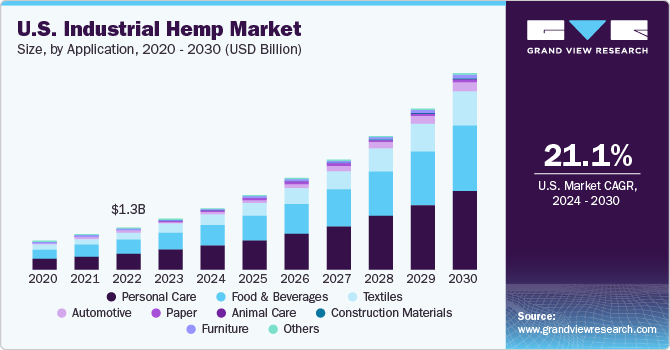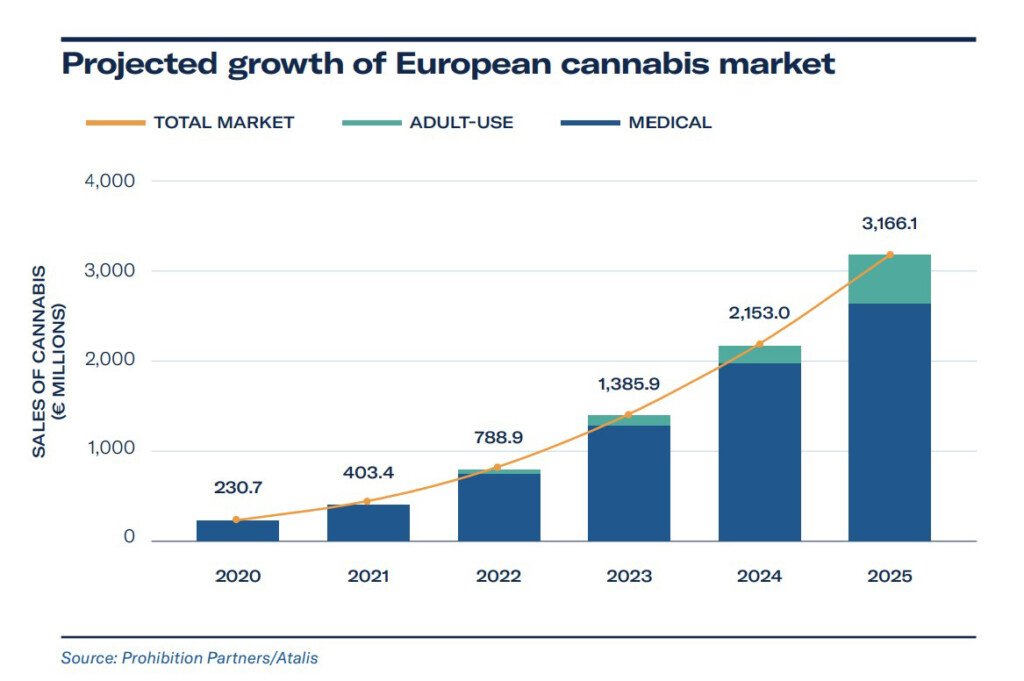The Ultimate Bucket list of Hemp Predictions: Economic Forecasts & Market Trends
Since the Industrial Revolution of the 18th century, consumption patterns have followed an unsustainable streak. In the last few centuries, short-term profits in capital gains have been prioritized over long-term environmental damage.
As per World Meteorological Organization (WMO), climate change has caused nearly $1.5 trillion in economic losses globally from 2010 to 2019, a staggering increase from $184 billion in the 1970s.
In the present scenario, adopting sustainable businesses and products is the need of the hour.
Additionally, how such can positively impact the economy is of keen interest.
According to MarketsandMarkets, the green technology and global sustainability market is estimated to grow from USD 28.6 billion in 2024 to USD 134.9 billion by 2030.
Sustainable businesses are an undeniable future for the economy. In this consideration, predictions for hemp industry growth show promise.
Hemp predictions by IMARC Group showed that the global industrial hemp market valued at approximately USD 6.2 billion in 2024 is projected to grow to USD 20.9 billion by 2033, representing a compound annual growth rate (CAGR) of 14.5% during the period from 2025 to 2033.

Let’s see how in the near future hemp provides multifaceted opportunities for economic improvement across major regions around the globe.
Hemp industry growth and economic predictions for the USA
- The US industrial hemp market is projected to reach USD 6.22 billion by 2030, growing at a CAGR of 21.1% from 2024 to 2030.
- Economic hemp predictions by the National Industrial Hemp Council (NIHC) estimate a $16 billion influence on the US economy by 2027. This includes contributions from various sectors such as fiber, grain, and CBD products.
- In the US, total hemp production is predicted to increase from 39,000 to 244,000 tonnes/year by 2030, positively impacting hemp industry growth.
- Industry forecasts hemp seed production will be 65 percent of production acreage by 2030.
- NIHC’s forecast for the export of industrial hemp products in the US is predicted to exceed $21 billion by 2026.
- The intermediate processing and downstream production of industrial hemp forecasts the empowerment of the US rural economies. There will be improved farm profitability, better rural livelihoods, and provision of market incentives for industrial hemp production.
- On the list of hemp predictions is the industry’s dramatic increase in farm-gate sales. This will be a driver of major economic reforms in the US agricultural landscape. NIHC predicts farm-gate sales of hemp to exceed $10 billion annually by 2025.
- The US hemp industry growth in the protein market is projected to reach USD 32.36 million by 2030, growing at a CAGR of 4.42% from 2025. The U.S. hemp protein powder market is expected to grow at a CAGR of 14.5% from 2024 to 2030.

Hemp industry growth and economic predictions for the UK
- The UK hemp market is projected to reach £1.3 billion by 2030.
- Under the 10-year HEMP-30 project, the aim is to significantly boost the cultivation and utilization of industrial hemp over a 10-year period. The program’s ambition is a 100-fold increase in hemp cultivation, growing from 800 hectares to 80,000 hectares by 2031.
- Under the HEMP-30 program, the growth of hemp cultivation is projected to occur 14 times faster than the predicted global average growth rate for industrial hemp.
- Hemp industry growth under the HEMP-30 project predicts that the UK’s share of the global industrial hemp market is expected to increase from 0.3% in 2020 to approximately 5% by 2030.
- The HEMP-30 initiative is expected to add approximately £700 million to the UK economy annually by 2030.
- Hemp predictions for the UK economy by the HEMP-30 program state that hemp cultivation on 80,000 hectares could produce around 640,000 tonnes of dry biomass per annum by 2031. This could be utilized for various applications, including construction materials and bioenergy.
- Based on current market trends and analyzing farmer interests, it was indicated that with improved hemp licensing, more than 220,000 hectares of hemp would be added to UK cultivation by 2027.
- Based on current market prices per kg of hemp biomass, a modest estimate would be the biomass generating £1.5 billion of additional income for the farmers in the UK.
- By 2027, the estimated value of the UK’s hemp shiv market is £240 million. This represents a revenue of £1,055 per hectare for farmers.
- Based on the predicted increase of 220,000 hectares of land for hemp cultivation in the UK, farmers can generate a revenue of £1.2 billion in carbon credits. This would open up a new income source currently unavailable to farmers. The farming industry will become more resilient as the need for subsidies is reduced.
- The hemp industry growth in the UK in medicinal cannabis is projected to grow to over £3.3 billion by 2030.
- The cannabis industry in the UK has the potential to generate more than 594,000 jobs, which will also help the UK achieve its carbon neutrality goals by 2050.
- The UK economy’s hemp predictions for the cannabis industry show £5.5 billion in annual tax revenue.

Hemp industry growth and economic predictions for Australia
- In Australia, the industrial hemp market is projected to grow from USD 9.91 billion in 2025 to USD 22.44 billion by 2030, reflecting a CAGR of 17.7% during this period.
- Hemp dominated the medical cannabis sector with a 74.1% share in 2023, indicating a strong consumer preference for hemp-based solutions. Hemp predictions for the Australian economy show that the medical cannabis market is anticipated to grow at a CAGR of 33.6%, reaching approximately USD 860.74 million by 2030.
- The growth of the legal cannabis market in Australia is being driven by increasing patient populations and the legalization of cannabis products. The market is expected to reach USD 540 million by 2030, with a noticeable CAGR of 27.8% from 2024 to 2030.

Hemp industry growth and economic predictions for Asia-Pacific
- The Asia Pacific industrial hemp market is projected to grow from USD 2.73 billion in 2025 to USD 19.03 billion by 2033, at a CAGR of 27.47% during this period.
- The industrial hemp market in China is expected to reach USD 4,393.7 million by 2030. In the product segment, hemp seeds seem to record the fastest growth during the forecast period. In the Asia Pacific, China’s hemp industry growth in the industrial hemp market is expected to lead the regional market in terms of revenue in 2030. The country has secured over half of the 606 hemp patents recorded worldwide.
- The hemp textile sector is expected to significantly contribute to market growth, fueled by rising consumer demand for sustainable and eco-friendly fabrics. The hemp fabric market is projected to grow at a CAGR of 32.37% from 2025 to 2032.
- For hemp predictions in the sustainable construction industry, the hempcrete market is set to record noticeable growth. The Asia Pacific hempcrete market is projected to grow at a CAGR of 6% from 2025 to 2030, with a revenue forecast of $6.98 billion by 2030. The drive behind this growth is the construction industry’s shift toward sustainable building materials.
- The China hempcrete market is expected to reach USD 4,226.1 million by 2030, growing at a CAGR of 6.7% from 2025 to 2030. In Asia Pacific, the China hempcrete market is expected to lead the regional market in terms of revenue in 2030.
- In the Asia Pacific hempcrete market, India is the fastest-growing regional market and is projected to reach USD 562.7 million by 2030.
- The Asia Pacific hemp fabric market is projected to grow at a CAGR of 32.37% from 2025 to 2032. The textile market-based hemp predictions show that hemp textiles will significantly contribute to market growth. The driving factor is rising consumer demand for sustainable and eco-friendly fabrics. Approximately 80% of hemp produced in China is used in the textile industry. China is a primary supplier of hemp products to the United States, East Asia, and Southeast Asia.

While concluding the bucket list of hemp predictions for different economies, an undeniable fact driving the growth of the hemp industry is evident—sustainability is the future. The predictions for a growing hemp industry on a global scale allude to the global trends toward a burgeoning market of sustainable products. Let’s look at a few more predictions for hemp industry growth on a global scale:
- Over the forecast period from 2025 to 2034, the global hemp clothing market is expected to expand at a CAGR of 26.6%, reaching a projected value of approximately USD 26.66 billion by 2034. Asia Pacific holds the largest market share, driven by countries like China, Japan, and India due to their agricultural workforce and rising demand for eco-friendly products.
- The global hemp-based foods market is expected to grow to USD 4.5 billion by 2030, reflecting a CAGR of 5.9% during the forecast period from 2025 to 2030. The global hemp protein powder market is projected to reach USD 1,031.1 million by 2035, growing at a CAGR of 10.4%. North America and Europe will lead the market due to a strong consumer base for plant-based products.
- The global hemp bioplastic market is expected to grow to around USD 290.7 million by 2031, recording a CAGR of 13.6% during 2021-2031.
There are variations in the economic insights across the world because of regional histories and evolving legal frameworks. For instance, there was a period of absence of industrial hemp production and manufacturing in the United States since World War II. Other countries like China and most of Europe continued uninterrupted development of their industrial hemp sectors. This opens up opportunities for bilateral and multilateral development collaborations to achieve sustainability goals.
Vishal Vivek
Vishal Vivek is the Founder and CEO of Ukhi, a pioneering bio-materials company dedicated to ending plastic pollution by converting agricultural waste into high-performance compostable polymers. With a background in sustainable entrepreneurship and over a decade of technology experience, he leads Ukhi’s vision to create scalable, planet-positive material solutions. Previously, Vishal founded the Hemp Foundation, where he empowered more than 1,000 farmers and advanced sustainable livelihood initiatives. His work has been recognized through awards such as the HDFC Parivartan Grant and featured in leading publications like Forbes and Entrepreneur. Times Group recognized him as a legendary entrepreneur and published his biography in “I Did IT- Vol 2” alongside social pioneers like Bindeshwar Pathak (Sulabh International) and Anshu Gupta (Goonj). Vishal has authored more than 200 articles on sustainability and hemp, reflecting his deep expertise and advocacy for regenerative solutions. His commitment to grassroots impact led him to live in the remote mountains of Uttarakhand, where he immersed himself in the lives of marginal farmers, understanding their challenges and co-creating economic opportunities through hemp-based initiatives. A deeply passionate innovator, Vishal often draws inspiration from seemingly impossible achievements: “If Elon Musk can make rockets reusable, or Dashrath Manjhi can carve a path through a mountain with rudimentary tools, why can’t we eliminate the demon of single-use plastic while uplifting struggling farmers? We will make it happen—whatever it takes.” Ukhi is proud to be supported by premier institutions including IIT Guwahati, NSRCEL-IIM Bangalore, Indian School of Business (Hyderabad), Indian Council of Agricultural Research (ICAR Pusa), and the Indian Institute of Packaging. Vishal is committed to demonstrating that business can be a powerful catalyst for global environmental and social good. Connect with Vishal Vivek
Related Posts
What makes hemp the perfect fabric for military uniforms?
[vc_row][vc_column][vc_column_text]History is suffused with incidents where a single person brings h
Plastic Pollutes For 500 Years, Hemp Packaging Decomposes In 6 Months
The durability and low cost of plastic has made it the preferred material for packaging. But it is t
Minnesota Becomes The First US State To Approve Hemp Seed Meal As Feed, Green Signals Market Expansion Of Hemp
In a milestone development, hemp seed meal has been approved for use as feed for laying hens by the



